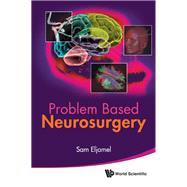
What is included with this book?
| Preface | p. xiii |
| History and Physical Exam | p. 1 |
| How to get the patient to tell you what is wrong. (The smart way of taking a succinct complete history of any illness) | p. 1 |
| How to elicit neurological signs effectively, demonstrate them with confidence and make a lasting impression. (The smart way of performing neurological physical examination 1) | p. 12 |
| How to examine the first two cranial nerves efficiently, with confidence and make a lasting impression. (The smart way of performing neurological physical examination 2) | p. 23 |
| How to examine the third, fourth and sixth cranial nerves efficiently, with confidence and make a lasting impression. (The smart way of performing neurological physical examination 3) | p. 32 |
| How to examine the face (fifth and seventh cranial nerves) efficiently, with confidence and make a lasting impression. (The smart way of performing neurological physical examination 4) | p. 45 |
| How to examine the eighth, ninth & tenth cranial nerves efficiently, with confidence and make a lasting impression. (The smart way of performing neurological physical examination 5) | p. 57 |
| How to examine the 11th and 12th cranial nerves efficiently, with confidence and make a lasting impression. (The smart way of performing neurological physical examination 6) | p. 69 |
| How to examine the motor system efficiently, with confidence and make a lasting impression. (The smart way of performing neurological physical examination 7) | p. 73 |
| How to examine the sensory system, coordination and gait efficiently and make a lasting impression. (The smart way of performing neurological physical examination 8) | p. 96 |
| Neurological Investigations | p. 109 |
| Computerised tomographic scan (CT): How to interpret CT-based images? | p. 109 |
| Magnetic resonance imaging (MRI): How to interpret MRI-based images? | p. 120 |
| Non-radiological neuro-investigations. How to interpret non-radiological neuro-investigations in a smart way? | p. 134 |
| Trauma (Head and Spinal Injured Patients) | p. 145 |
| Head injuries and head trauma. How to manage a patient presenting with a head injury? | p. 145 |
| Spinal trauma and traumatic spinal cord syndromes. How to manage a patient following spinal trauma? | p. 163 |
| Sudden Headache or Collapse (SAH, ICH, Seizures) | p. 185 |
| Sudden headache and subarachnoid haemorrhage. How to manage a patient presenting with sudden headache? | p. 185 |
| Collapse and sudden focal neurological deficits. How to manage a patient presenting with sudden focal neurological deficit or collapse? | p. 209 |
| Collapse, seizures, fits and funny turns. How to manage a patient presenting with seizure or funny turn? | p. 220 |
| Raised ICP (Tumours, Abscess and Hydrocephalus) | p. 233 |
| Raised ICP and primary malignant brain tumours. How to manage a patient presenting with raised ICP due to primary malignant brain tumours (PMBT)? | p. 233 |
| Raised ICP and secondary brain tumours. How to manage a patient presenting with raised ICP due to secondary brain tumour (SBT)? | p. 258 |
| Raised ICP, brain abscess and CNS infections. How to manage a patient presenting with raised ICP due to CNS infection? | p. 265 |
| Raised ICP and hydrocephalus. How to manage a patient presenting with raised ICP due to hydrocephalus? | p. 281 |
| Visual Symptoms (Meningiomas, Pituitary Adenomas) | p. 307 |
| Visual failure and intracranial meningiomas. How to manage a patient presenting with compressive optic neuropathy? | p. 307 |
| Visual symptoms and pituitary adenomas. How to manage a patient presenting with visual field defect? | p. 324 |
| Hearing Loss, Ataxia, Vertigo and Facial Pain (CPA Lesions) | p. 345 |
| Hearing loss and cerebellopontine angle (CPA) lesions. How to manage a patient presenting with hearing loss? | p. 345 |
| Facial pain and trigeminal neuralgia. How to manage a patient presenting with facial pain? | p. 356 |
| Tremor (Parkinson's Disease and Dystonia) | p. 369 |
| Tremor and Parkinson's disease. How to manage a patient presenting with tremor? | p. 369 |
| Movement disorders and dystonia. How to manage a patient with dystonia? | p. 376 |
| Para-/Tetraparesis (Spinal Compression) | p. 381 |
| Bilateral limb paresis (malignant spinal compression). How to manage suspected malignant spinal compression? | p. 381 |
| Bilateral limb paresis (benign spinal compression). How to manage suspected benign spinal compression? | p. 396 |
| Bilateral limb paresis (spinal infections). How to manage suspected spinal infection? | p. 410 |
| Pain, Weakness or Numbness in a Limb (Radiculopathy, Myelopathy and Peripheral Nerve Pathologies) | p. 421 |
| Brachalgia, myelopathy and cervical disc prolapse. How to manage a patient presenting with arm pain or myelopathy? | p. 421 |
| Sciatica, cauda equina and lumbar disc prolapse. How to manage a patient presenting with leg pain or cauda equina? | p. 429 |
| Hands and feet numbness and peripheral nerves. How to manage a patient presenting with hand or foot numbness? | p. 443 |
| Appendices | p. 451 |
| Index | p. 473 |
| Table of Contents provided by Ingram. All Rights Reserved. |
The New copy of this book will include any supplemental materials advertised. Please check the title of the book to determine if it should include any access cards, study guides, lab manuals, CDs, etc.
The Used, Rental and eBook copies of this book are not guaranteed to include any supplemental materials. Typically, only the book itself is included. This is true even if the title states it includes any access cards, study guides, lab manuals, CDs, etc.